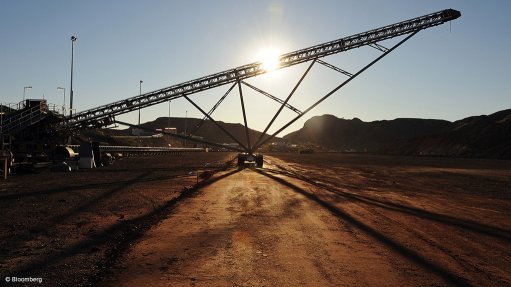
Photo by: Bloombeg
PERTH (miningweekly.com) – A December prefeasibility study (PFS) into iron-ore miner Atlas Iron’s Corunna Downs project has estimated that the project could deliver about four-million tonnes a year of lump and fines direct shipping ore (DSO), over a mine life of between five and six years.
The PFS estimated that the project would require a capital investment of between A$35-million and A$40-million, with C1 cash costs estimated at between A$37/t and A$42/t.
Should the project proceed to development, the Corunna Downs operation had the potential to deliver replacement tonnes for the Abydos and Wodgina mines, which were both expected to cease mining over the next two to three years.
Corunna Downs, which is located between the operating Mt Webber mine and the planned McPhee operation, has a mineral resource of 65.4-million tonnes, grading 57.2% iron.
Atlas said at the time of the PFS reveal that following the completion of the study, a maiden ore reserve of 21.1-million tonnes, at 57% iron, had also been established at Corunna Downs.
Furthermore, the iron-ore miner noted that with the positive outcome of the Corunna Downs PFS, the McPhee deposit could be proven viable should the cost regime demonstrated in the PFS be replicated at the proposed McPhee site.
The development of the Corunna Downs project was subject to necessary approvals, as well as a recovery in the iron-ore price. Atlas noted that no decision had been made on whether the project would proceed to development, adding that any such decision would only be made after a thorough consideration of the company’s financial and operating conditions, as well as the prevailing and anticipated future market conditions.
In the meantime, Atlas has signed a restructuring support agreement to restructure its debt.
The miner inked agreements with more than 75% of its Term Loan B (TLB) lenders, and amended its existing syndicated facility agreement.
Under the two agreements, Atlas would make a pay down of the TLB loan of some $10-million and issue shares and options to the TLB lenders in exchange for the lenders retiring $132-million of debt.
The TLB lenders would hold a combined 70% of the company’s shares and options on issue, immediately post the restructure.
The issue of these shares and options would be subject to shareholder approval.
Furthermore, the existing syndicated facility agreement would be amended to include a covenant that cash was not to fall below A$55-million on any day during the implementation of the interim covenant.
On implementation of the financial restructuring, Atlas would have reduced its term loan debt from $267-million to $135-million, extended the maturity date from December 2017 to April 2021, and reduced its cash interest expense by over 65% as a result of the lower debt balance and reduced interest rate.
In addition to its debt restructure, Atlas had also agreed with its contractors a number of cost reductions which were expected to lower cash costs during the financial restructure by between A$2/t and A$4/t.
For the full 2016, C1 cash costs were expected to reach between A$35/t and A$38/t, with Atlas expected to deliver between 14-million and 15-million tonnes of ore.